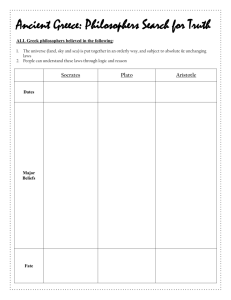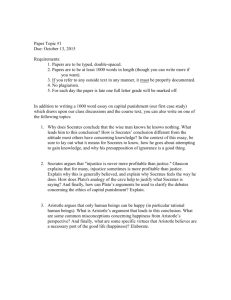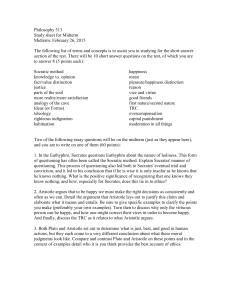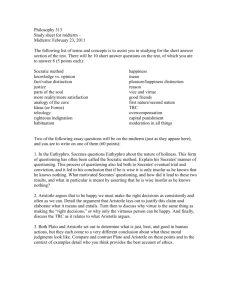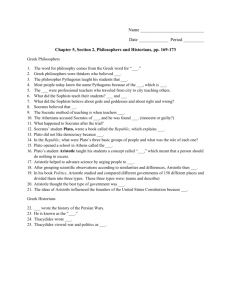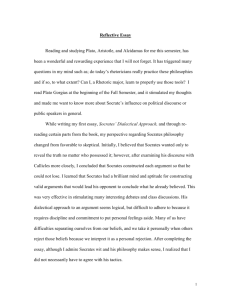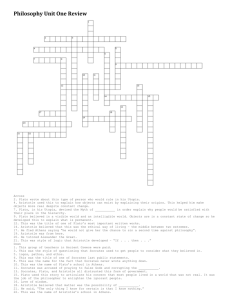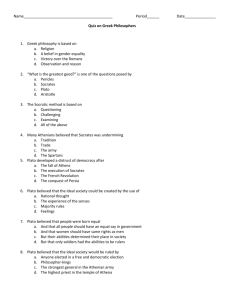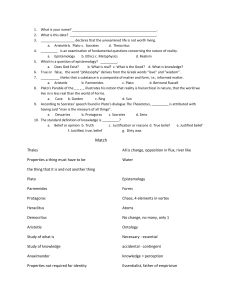An Introduction to Aristotle`s Categories
advertisement
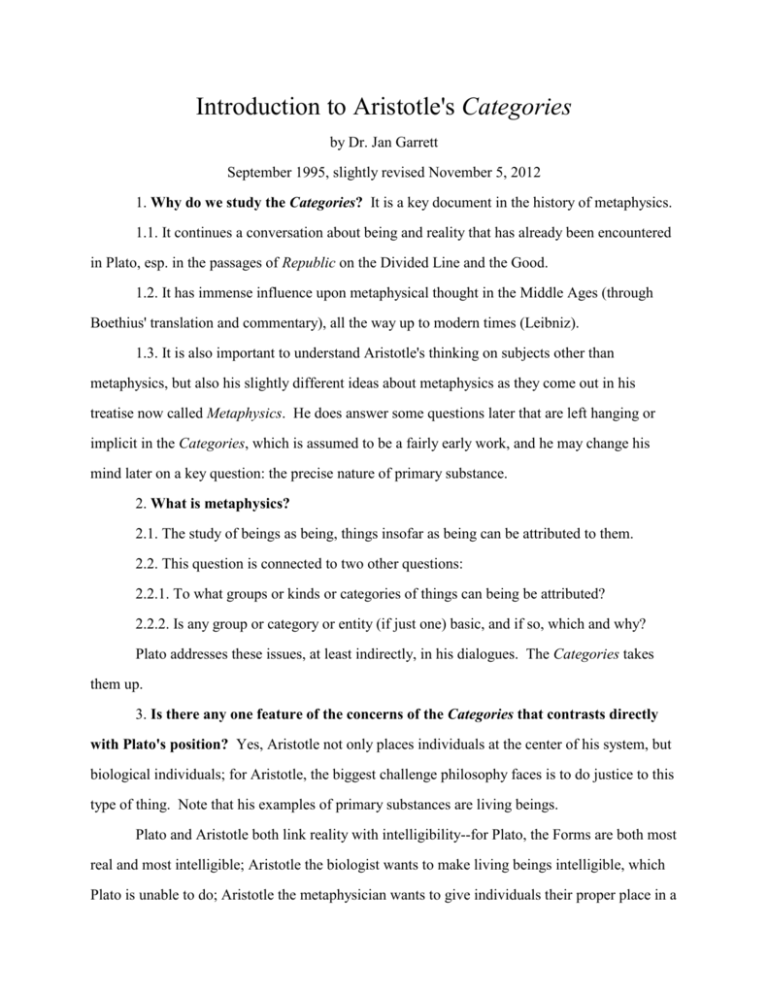
Introduction to Aristotle's Categories by Dr. Jan Garrett September 1995, slightly revised November 5, 2012 1. Why do we study the Categories? It is a key document in the history of metaphysics. 1.1. It continues a conversation about being and reality that has already been encountered in Plato, esp. in the passages of Republic on the Divided Line and the Good. 1.2. It has immense influence upon metaphysical thought in the Middle Ages (through Boethius' translation and commentary), all the way up to modern times (Leibniz). 1.3. It is also important to understand Aristotle's thinking on subjects other than metaphysics, but also his slightly different ideas about metaphysics as they come out in his treatise now called Metaphysics. He does answer some questions later that are left hanging or implicit in the Categories, which is assumed to be a fairly early work, and he may change his mind later on a key question: the precise nature of primary substance. 2. What is metaphysics? 2.1. The study of beings as being, things insofar as being can be attributed to them. 2.2. This question is connected to two other questions: 2.2.1. To what groups or kinds or categories of things can being be attributed? 2.2.2. Is any group or category or entity (if just one) basic, and if so, which and why? Plato addresses these issues, at least indirectly, in his dialogues. The Categories takes them up. 3. Is there any one feature of the concerns of the Categories that contrasts directly with Plato's position? Yes, Aristotle not only places individuals at the center of his system, but biological individuals; for Aristotle, the biggest challenge philosophy faces is to do justice to this type of thing. Note that his examples of primary substances are living beings. Plato and Aristotle both link reality with intelligibility--for Plato, the Forms are both most real and most intelligible; Aristotle the biologist wants to make living beings intelligible, which Plato is unable to do; Aristotle the metaphysician wants to give individuals their proper place in a Introduction to Aristotle's Categories Page 2 metaphysical scheme. 4. What are categories in Aristotelian philosophy? On the face of it, they are the largest classifications of beings, according to Aristotle. (Warning: there are actually quite of few things Aristotle does not cover in the Categories.) They are metaphysical divisions or classifications of realities. There are ten of them, with substance somehow most important. The other nine include quantity, quality, relation, place, time, action, passion, attitude, having. (The last two are not very important, and the full list of ten is only mentioned twice by Aristotle.) 5. Are items in each category all alike? In a sense yes, in a sense no. 5.1. Quality includes red, green, sweet, sour, brave, cowardly, pious, impious; color, taste, virtue, vice, bodily quality; quality of soul. All these belong to the category of quality, and so far they are similar. 5.2. But, obviously, qualities differ. 5.2.1. They include different colors or different tastes. 5.2.2. Color itself is different from taste, and bodily quality is different from quality of soul. 5.2.3. Color is on a different level from red and green, and bodily quality from color. We can distinguish various levels, from individuals or highly specific entities to larger groups or classes which include them, to even larger groups, all the way up to the category level itself. Aristotle seems to think that the same kind of hierarchy can be found for each category. For example, in the category of substance, there are individuals (this human, this horse); there are species (human, horse); there are higher genera (animal, plant); and there is the category itself (substance). 6. To what does Aristotle in the Categories attribute basic reality? He attributes more basic reality to individuals than to species or genera (the larger classes that include them); and more basic reality to individuals in the category substance than to individuals in other categories. 7. How do we pick out the most basic items, substances? Aristotle mentions several Introduction to Aristotle's Categories Page 3 "marks of substance." 7.1. Primary substances are neither said of a subject nor in a subject (2a12-13) [We'll come back to this later.] 7.2. The existence of anything else (secondary substances or things in a subject) depends on the existence of primary substances. (2b5-7) 7.3. Every [primary] substance signifies a "certain this" or "this such" or "this such and such" (tode ti); it is individual and numerically one. (3b10-12) [The "ti" or "such-and-such" is best replaced with a term for a natural kind or type like "human," "horse," "oak".] 7.4. There is nothing contrary to a substance. (There is nothing contrary to Socrates or human, though there is something contrary to wisdom.) (3b24-25) 7.5. Primary substances are able to admit contraries. (Socrates is now cold, now hot.) (4a10ff) 7.6. Primary substance does not admit of a more or a less. Socrates is just as much a substance as Dobbin. Two human beings are equally substances. (3b33ff) 7.7. Note: (7.4) also fits secondary substances. There is nothing contrary to "human being." (7.6) also fits same-level secondary substances. Thus, if human being is the species that includes Socrates, Omar and Chen, and horse is the species that includes Dobbin and Sea Biscuit, human being is no more substance than Dobbin. But secondary substances are less substances than primary, and genera (e.g., animal) are less substances than species. (The word translated "substances"--ousiai--clearly connotes basic things.) 8. Explain "present in" and "said of. These are technical terms within this particular text Categories. They parallel in some way the predication relation. Human and pale are predicated of Socrates, because we say that Socrates is human and Socrates is pale. But human is said of Socrates, in the terminology of the Categories, and animal is said of both human and Socrates. Human is a species which includes Socrates, animal is a genus which includes human. Pale, on the other hand, may be present in Socrates, but it is not said of him. Color is said of pale, for the same reason as human is said of Socrates. (Pale might be defined, for example, as a Introduction to Aristotle's Categories Page 4 light color.) What precisely is the difference between “said of” and “present in”? Let's introduce the term "universal" here; things that are said of subjects are universals, that is, they collect what they are said of because of some shared feature; thus color collects pale and dark, human collects Socrates and Callias. Aristotle says in one place that universals in the category of substance, like human, animal, etc., make clear or reveal primary substance while presumably other things we might attribute to this man Socrates does not. If P is said of S, then P necessarily and by definition applies to S. Human is said of Socrates, hence Socrates is necessarily human. What is more if P can be said (legetai kata) of S, then the definition (logos) of P also necessarily applies to S; if human can be said of Socrates, and if rational animal is the definition of human, then necessarily Socrates is a rational animal. Contrast: Pale is present in Socrates, but Socrates can receive a tan (Socrates is not necessarily pale, nor is Socrates necessarily of light color--I suppose that "of light color" defines pale.) The logical classification "not present in a subject and not said of a subject" picks out primary substances. It does so by excluding categories other than substance and by excluding genera and species. 9. How does Aristotle's view here compare with Plato's Middle Dialogues view--the view expressed in the Phaedo and the Republic? Plato Middle Dialogues Aristotle in Cat. One Over Many: There are entities which group other entities by their commonalities. Forms in relation to visible particulars. Genera and species in relation to lower genera and individuals. Formula for expressing this. The many [visible] F's participate in the F [the corresponding Form] A genus or species is said of subjects. Introduction to Aristotle's Categories Relative Reality The Forms are more real than particulars. Page 5 What is not said of a subject and not present in a subject is metaphysically basic. Secondary substances and things present in a subject are real but less basic. (1) Generally, he accepts the one-over-many doctrine [with the qualification that things may be said homonymously--terms may be used ambiguously. Where they are not, however, there is some thing--some form or species which they have in common.] (2) He does not speak of S's participating in a form P--he drops that way of speaking, but substitutes for it the phrase "P is said of S." (3) He does not insist, as Plato did, that the form is more real than the individual that it defines. Humanity is not more real than Socrates; Equality is not more real than the concrete equality of two sticks. If anything, the individual living being is more real than any species or genus to which it may belong, and the individual piece of knowledge more real than any species or genus to which it may belong. [Because species and genera are less real for Aristotle now than they were for Plato, the problem of a duplicate reality independent of the reality of living individuals--which Plato faced in the Parmenides does not really arise.] But Aristotle's sketch of a system in Categories is far from complete. He only discusses living individuals, their species and genera, qualities, quantities, places, etc. He doesn't discuss (i) inorganic matter--earth, air, fire, water, metals; (ii) the heavenly bodies; (iii) artifacts; and, most importantly, (iv) the internal structures and stuffs found in living individuals. Nor does he provide any justification for treating living individuals only as substances, as opposed to the atoms of the atomists, or the stuffs of Anaxagoras, or the numbers of Pythagoras and Speusippus.
